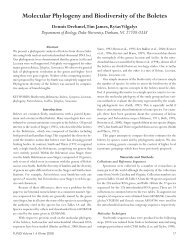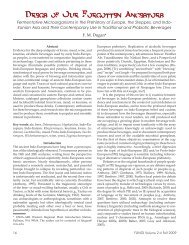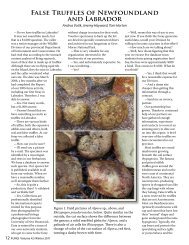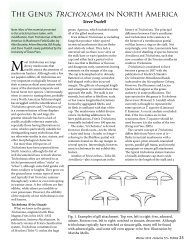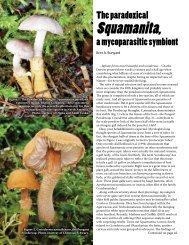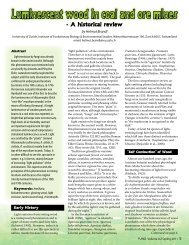Notes from Under- ground - FUNGI Magazine
Notes from Under- ground - FUNGI Magazine
Notes from Under- ground - FUNGI Magazine
Create successful ePaper yourself
Turn your PDF publications into a flip-book with our unique Google optimized e-Paper software.
Fungal Metamorphosis and the Surrealist Aesthetic<br />
The stories of Edgar Allan Poe (1809–1849) are so well known<br />
to American readers that they may induce a yawn of ennui instead<br />
the expected frisson of horror, especially in an age supersaturated<br />
with cinematic terror and gratuitous gore. Yet, mention the name<br />
Lautreamont, and one will invite only stares of incomprehension.<br />
Isidore Ducasse (1846–1870), or Lautreamont, was the author<br />
of Les Chants de Maldoror, a work of such hyperbolic malignity of<br />
the imagination that Andre Breton championed him unconditionally<br />
as the purest precursor to the surrealist enterprise. Both Poe<br />
and Lautreamont intuitively grasped the mutative flux of the natural<br />
world, and both populate their narratives with an abundance<br />
of fauna and flora, mythical and otherwise, if only better to unsettle<br />
the reader and blaspheme the Creator. Some scholars have<br />
disputed that Poe was particularly knowledgeable about natural<br />
history, perhaps because he abhorred “the triumph of mechanical<br />
reason” at the expense of an integrated vision of science and poetry.<br />
22 However, his stories abound in references to vegetation,<br />
wildflowers, insects, reptiles, mammals, and not a few mushrooms,<br />
truffles, and mildews as if to catalogue completely the known<br />
world of flora and fauna in the course of spinning crazy tales of<br />
disaster, intrigue, and terror. Poe may have excelled in recounting<br />
fantastic stories of travel and adventure, but his very first publication<br />
was a textbook on conchology, and his prescient deployment<br />
of technological invention and cosmological speculation culminated<br />
in his prose-poem Eureka, dedicated to Alexander von<br />
Humboldt and prefiguring Albert Einstein’s theory of relativity.<br />
Fungi—provoking wonder or arising <strong>from</strong> decay—populate<br />
Poe’s stories. In “The Pit and the Pendulum” the peculiar stench<br />
of “decayed fungus” is the olfactory counterpart to a trial of horror<br />
in a slime-covered dungeon of the Inquisition; in “The Premature<br />
Burial” decay that emanates <strong>from</strong> open graves does so with<br />
“phosphoric radiance.” Poe folds these images together in his tale<br />
“The Thousand-and-Second Tale of Scheherazade” in which a cavedwelling<br />
species of “cryptogamous fungus . . . emits an intense<br />
phosphorescence.” In “The Angel of the Odd” a dinner which includes<br />
a “dyspeptic truffle” instigates a dreamlike encounter with<br />
an evil sprite, and several other stories are littered with molds<br />
and lichens along with a retinue of poisonous plants. It is in “The<br />
Fall of the House of Usher,” one of the greatest short stories of<br />
the genre, that fungi receive their key theoretic position as an<br />
occult principle in Poe. The house, a locus for the story’s action<br />
and a metaphor for Roderick Usher’s cranium, features a façade<br />
in which “minute fungi overspread the whole exterior, hanging in<br />
a fine tangled web-work <strong>from</strong> the eaves” and joining the stonework<br />
to camouflage a perilous fissure. This alone would seem an<br />
adequate portrait of dilapidation, but Poe carries the scenario<br />
further by embodying it in Usher’s psychopathic belief in the “sentience<br />
of all vegetable things,” i.e., that vegetable life, including<br />
the fungi, is capable of feeling or perception, possibly of thinking.<br />
Usher’s belief was “connected . . . with the gray stones [and] the<br />
conditions of the sentience had been here…fulfilled in the method<br />
of collocation of these stones . . . as well as in that of the many<br />
fungi which overspread them, and of the decayed trees which stood<br />
around.” 23 Far <strong>from</strong> mere adornment, Poe’s fungi represent a<br />
strange life form insinuated into a desolated environment, imbued<br />
with the malignancy of decay, and supernaturally sentient at<br />
the very border of life and death. That we find the “dead” Madeleine<br />
Usher alive in her tomb at the penultimate moment before the<br />
cataclysmic destruction of the entire house supports the offstage<br />
role of fungi as liminal entities having more control over human<br />
destiny than we would prefer to believe. In Jean Epstein’s fine<br />
1928 cinematic version of Poe’s story, the fungi do not appear<br />
until we enter Madeleine’s crypt, where we find a crazy array of<br />
mushrooms decidedly crystalline in appearance. 24 Fungi are macabre,<br />
metaphoric bridges <strong>from</strong> life to death and back again, symbolizing<br />
transit between the natural and supernatural just as they<br />
themselves seem to be unpredictably transformative in so many<br />
guises, in so many different ways.<br />
The nineteenth-century French illustrator Charles Meryon<br />
(1821–1868) produced an etching in 1860 entitled “The Sickly<br />
Cryptogam.” In it, a convoluted, mushroom-like growth seems<br />
to feed upon itself, as if it had coalesced by anastomosis into a<br />
topological enigma like a Klein bottle. Meryon’s cryptogam would<br />
be a fitting emblem for Lautreamont’s Les Chants de Maldoror, which<br />
posits an enigmatic world superabundant with menacing wildlife<br />
and seething with the bestial, the pestilential, and the unexplained.<br />
A literary beacon of the first magnitude for the surrealists,<br />
Lautreamont unleashed Les Chants de Maldoror upon the world in<br />
1869, and it remains an uncanny counterpart to Charles Darwin’s<br />
theory of evolution by natural selection, in which life forms appear<br />
in riotous profusion and endless metamorphosis. The natural<br />
history index to Lautreamont is formidable: there are approximately<br />
70 botanical, 34 entomological, 60 ornithological, 106<br />
zoological, 11 mycological, and 9 fabulous taxa represented in<br />
Les Chants de Maldoror, amid countless other general references to<br />
the living world, a bestiary that eclipses even that of Poe. What is<br />
more, Lautreamont’s surreal taxonomy<br />
subverts the fixed chain of being<br />
in other ways: e.g., in the portrayal<br />
of humankind under animal guises and<br />
in cross fertilizations of incompatible<br />
species. For example, a man mates<br />
with a louse, producing a swarming<br />
cluster of indescribable hybrid mon-<br />
Charles Meryon – The Sickly<br />
Cryptogam (etching), 1860<br />
sters that writhe like liquid mercury<br />
and form tributaries reminiscent of<br />
Dictyostelium discoideum. If we were to<br />
26 <strong>FUNGI</strong> Volume 2:1 Spring 2009



